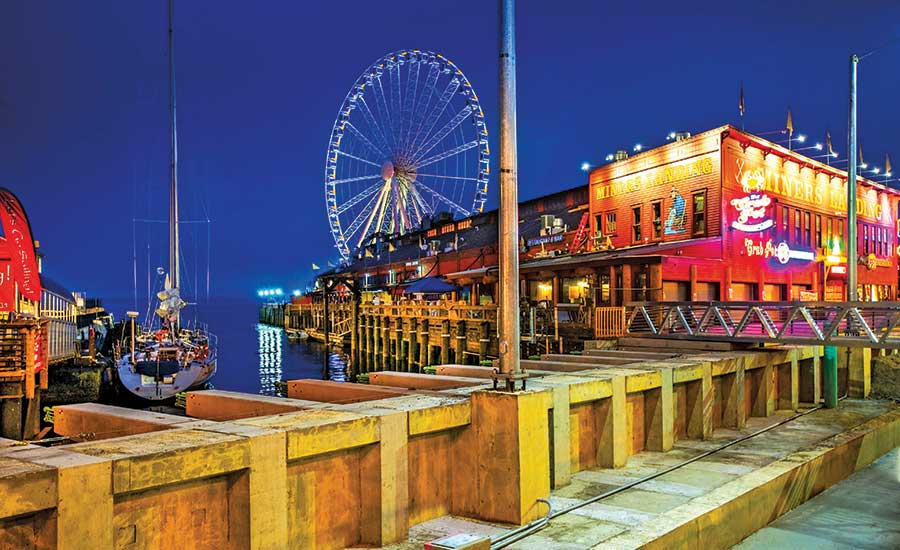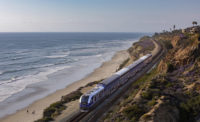Sustainability, collaboration and state-of-good-repair needs are shaping transportation designs, with less emphasis on expansion and more on enhancing existing capacity. Disruptive technologies, particularly connected vehicles and drones, continue to pose challenges to planners of all transportation modes.
“We have a big trend that is happening: significant innovation-driven change,” says William Baumgardner, leader of intelligent mobility for Arup. “It is creating uncertainty for infrastructure planning that we’ve never dealt with before. We have to think through a phasing strategy that is flexible enough to respond to uncertainty.”
The expected increase in automated mobility, including not only intelligent vehicles, drones and shared-ride services but also public transit and data from monitored infrastructure, will have implications for parking structures, which could be repurposed, he adds.
Related Link
ENR 2017 Top Design Firms Sourcebook
But it is not just disruptive technologies and data driving the trend. The younger generations as well as baby boomers are increasingly living in cities and demanding transportation choices other than vehicles. “It’s a major change in mind-set. Obviously, a demand for urban living is huge,” says Christine Carlyle, principal director of planning with architect Solomon Cordwell Buenz. “The demand for areas around transit are pretty high. It’s making for a more diverse building envelope and ways of using that space. There’s a lot more focus on place-making. The conversation is about the social aspect as well as the economic and physical.”
The existing infrastructure’s state-of-good-repair status “is still the focus among clients, especially in the Northeast,” says Steve McElligott, senior vice president of transportation for VHB. “The design projects we are seeing come out are focused on that, whether roads and bridges or transit and rail. We’re seeing a minimal amount of capacity improvements.”
Capacity-building may not be prevalent, but firms are seeing more work to increase resiliency and sustainability. “Superstorm Sandy opened our eyes and is still impacting us,” says Richard Amodei, senior vice president with STV Inc., which, since that event, has seen increased work on protecting tristate-area subways and railyards.
On the other coast, Parsons Transportation Group is involved in a $5-billion program at the Port of San Francisco to address seismic and flooding concerns and led the design of the Elliott Bay Seawall in Seattle. “Cities are looking for solutions on the changing environment, life cycle, increase in urban development and adaptability,” says Mike Johnson, Parsons Group president.
City- and regionally driven design is increasingly prevalent as the federal funding situation remains murky, despite White House talk of a trillion-dollar infrastructure program. Last November, voters passed initiatives for state transportation projects worth billions of dollars. However, “without consistent federal funding, our state agencies have fewer plans on the shelf ready to go than they ever have,” says VHB Chairman Robert Brustlin. Further, Michael McArdle, chief development officer, adds, “Agencies are hesitant to try to go out and even think about designing a project for fear of getting everyone excited, then not being able to follow through.”
Trillion-dollar program or not, the situation is pushing ever-more public-private partnerships and alternative project delivery methods. Noting Canada’s ripe P3 market, T.Y. Lin International Chairman David Goodyear says that, “in the U.S., I’d like to say it would be a good arrow in the quiver that we’ve underutilized.” He adds, “Will we further consolidate delivery models? Could there be more integration with financing, construction and design? It would be a change for the U.S. but not in the world.”
But change is driven by necessity. “We will certainly see P3 as a more common delivery method simply because we don’t have the public funding stream available,” says Parsons’ Johnson. “Moreover, we’ll continually drive parametric design or, eventually, artificial intelligence for design solutions. Design tools such as building information modeling or virtual reality are changing the way the public comments [on] and views projects through the design and development phases.”



